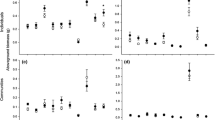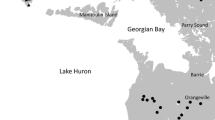Abstract
Positive feedback between invasive and native plants may contribute to invasive species dominance, although this pattern may not be general for all invasions and has not been well explored in woodland systems. We examined the pairwise feedback relationship between Euonymus fortunei, an emerging invader of North American deciduous forests, and Asarum canadense, a co-occuring native groundcover, to determine whether positive feedback might contribute to Euonymus dominance. In a greenhouse in Bloomington, Indiana, USA, we conditioned live woodland soil via growth with either Euonymus or Asarum, then used conditioned soils to inoculate monocultures and pairwise mixtures of each species. After eight weeks, we harvested plants and measured percent growth. We found evidence for positive plant-soil feedback between Euonymus and Asarum. Euonymus grew better in soil conditioned by conspecifics than in soil conditioned by Asarum, whereas total Asarum growth was not different in soil conditioned by conspecifics vs. Euonymus. These results held whether Euonymus and Asarum grew in monoculture or pairwise competition. This study supports a role for positive plant-soil feedback as a driving factor behind the invasion of Euonymus fortunei. Future work should examine the role of abiotic vs. biotic factors in mediating feedback between Euonymus and Asarum. Furthermore, researchers should examine pairwise feedback between Euonymus and other native species in order to better understand the role of positive feedback in Euonymus invasion. By evaluating the importance of this and other possible invasion mechanisms, we can improve our understanding of invasion ecology while facilitating management of harmful invasive species.


Similar content being viewed by others
References
Bergeron C, Marston A, Gauthier R, Hostettmann K (1996) Screening of plants used by North American Indians for antifungal, bactericidal, larvicidal, and molluscicidal activities. International Journal of Pharmacognosy 34(4):233–242
Bever JD (2003) Soil community feedback and the coexistence of competitors: conceptual frameworks and empirical tests. New Phytologist 157(3):465–473
Bever JD, Dickie IA, Facelli E, Facelli JM, Klironomos J, Moora M, Rillig MC, Stock WD, Tibbett M, Zobel M (2010) Rooting theories of plant community ecology in microbial interactions. Trends in Ecology & Evolution 25(8):468–478. doi:10.1016/j.tree.2010.05.004
Bever JD, Westover KM, Antonovics J (1997) Incorporating the soil community into plant population dynamics: the utility of the feedback approach. Journal of Ecology 85(5):561–573
Callaway RM, Aschehoug ET (2000) Invasive plants versus their new and old neighbors: A mechanism for exotic invasion. Science 290(5491):521–523
Cockfield SD, Potter DA (1986) Interaction of Euonymus scale (Homoptera, Diaspididae) feeding damage and severe water-stress on leaf abscission and growth of Euonymus-fortunei. Oecologia 71(1):41–46
Diez JM, Dickie I, Edwards G, Hulme PE, Sullivan JJ, Duncan RP (2010) Negative soil feedbacks accumulate over time for non-native plant species. Ecology Letters 13(7):803–809. doi:10.1111/j.1461-0248.2010.01474.x
Ehrenfeld JG, Ravit B, Elgersma K (2005) Feedback in the plant-soil system. In: Annual Review of Environment and Resources, vol 30. Annual Review of Environment and Resources. pp 75-115. doi:10.1146/annurev.energy.30.050504.144212
Hierro JL, Maron JL, Callaway RM (2005) A biogeographical approach to plant invasions: the importance of studying exotics in their introduced and native range. J Ecol 93(1):5–15. doi:10.1111/j.1365-2745.2004.00953.x
Hutchison M (1992) Vegetation management guideline—Wintercreeper or climbing Euonymus (Euonymus-fortunei). Natural Areas Journal 12(4):220–221
Keane RM, Crawley MJ (2002) Exotic plant invasions and the enemy release hypothesis. Trends Ecol Evol 17(4):164–170
Klironomos JN (2002) Feedback with soil biota contributes to plant rarity and invasiveness in communities. Nature 417(6884):67–70
Kulmatiski A, Beard KH, Stevens JR, Cobbold SM (2008) Plant-soil feedbacks: a meta-analytical review. Ecology Letters 11(9):980–992. doi:10.1111/j.1461-0248.2008.01209.x
Mangan SA, Schnitzer SA, Herre EA, Mack KML, Valencia MC, Sanchez EI, Bever JD (2010) Negative plant-soil feedback predicts tree-species relative abundance in a tropical forest. Nature 466(7307):U710–752. doi:10.1038/nature09273
McCutcheon AR, Ellis SM, Hancock REW, Towers GHN (1992) Antibiotic screening of medicinal plants of the British-Columbian native peoples. Journal of Ethnopharmacology 37(3):213–223
Mills KE, Bever JD (1998) Maintenance of diversity within plant communities: Soil pathogens as agents of negative feedback. Ecology 79(5):1595–1601
Molofsky J, Bever JD (2002) A novel theory to explain species diversity in landscapes: positive frequency dependence and habitat suitability. Proceedings of the Royal Society of London Series B-Biological Sciences 269(1508):2389–2393. doi:10.1098/rspb.2002.2164
Motto MG, Secord NJ (1985) Composition of the essential oil from Asarum-canadense. Journal of Agricultural and Food Chemistry 33(5):789–791
Nijjer S, Rogers WE, Siemann E (2007) Negative plant-soil feedbacks may limit persistence of an invasive tree due to rapid accumulation of soil pathogens. Proc R Soc B-Biol Sci 274(1625):2621–2627. doi:10.1098/rspb.2007.0804
Petermann JS, Fergus AJF, Turnbull LA, Schmid B (2008) Janzen-Connell effects are widespread and strong enough to maintain diversity in grasslands. Ecology 89(9):2399–2406
Pinheiro J, Bates D, DebRoy S, Sarkar D, Team TRC (2009) nlme: Linear and Nonlinear Mixed Effects Models. R Package version 3.1-96 edn
Pringle A, Bever JD, Gardes M, Parrent JL, Rillig MC, Klironomos JN (2009) Mycorrhizal Symbioses and Plant Invasions. Annual Review of Ecology Evolution and Systematics 40:699–715. doi:10.1146/annurev.ecolsys.39.110707.173454
R_Development_Core_Team (2009) R: A language and environment for statistical computing. R Foundation for Statistical Computing, Vienna, Austria
Reinhart KO, Packer A, Van der Putten WH, Clay K (2003) Plant-soil biota interactions and spatial distribution of black cherry in its native and invasive ranges. Ecology Letters 6(12):1046–1050. doi:10.1046/j.1461-0248.2003.00539.x
Reynolds HL, Packer A, Bever JD, Clay K (2003) Grassroots ecology: Plant-microbe-soil interactions as drivers of plant community structure and dynamics. Ecology 84(9):2281–2291
Reynolds HL, Rajaniemi TK (2007) Plant interactions: competition. Functional Plant Ecology, 2nd edn. CRC Press, Taylor & Francis Group, Boca Raton, FL. doi:10.1007/s00442-004-1666-4
Salihu S, Derr JF, Hatzios KK (1999) Differential response of ajuga (Ajuga reptans), wintercreeper (Euonymus fortunei), and dwarf burning bush (Euonymus alatus ‘Compacta’) to root- and shoot-applied isoxaben. Weed Technology 13(4):685–690
Schwegman JE (1996) Euonymus fortunei–wintercreeper. In: Randall JM, Marinelli J (eds) Invasive plants: Weeds of the global garden. Handbook #149. Brooklyn Botanic Garden, Brooklyn, NY, p 55
Shannon S, Flory SL, Reynolds H (2011) Competitive context alters plant-soil feedback in an experimental woodland community. Oecologia. doi:10.1007/s00442-011-2195-6
Stinson KA, Campbell SA, Powell JR, Wolfe BE, Callaway RM, Thelen GC, Hallett SG, Prati D, Klironomos JN (2006) Invasive plant suppresses the growth of native tree seedlings by disrupting belowground mutualisms. Plos Biol 4(5):727–731. doi:10.1371/journal.pbio.0040140
Swearingen J, Slattery B, Reshetiloff K, Zwicker S (2010) Plant Invaders of Mid-Atlantic Natural Areas 4th ed, 4th edn. National Park Service and U.S, Fish and Wildlife Service, Washington, DC
Swedo BL, Glinka C, Rollo DR, Reynolds HL (2008) Soil bacterial community structure under exotic versus native understory forbs in a woodland remnant at Indiana University. Proceedings of the Indiana Academy of Sciences 117(1):7–15
Van Driesche R, Kingsley P, Rose M, Bryan M (1998) Effect of euonymus scale (Homoptera : Diaspididae) on Euonymus spp. survival in southern New England, with estimates of economic costs of pest damage. Environmental Entomology 27(2):217–220
Acknowledgements
We would like to thank two anonymous reviewers for helpful comments on our manuscript. Thanks to Stephanie Dickinson of the Indiana Statistical Consulting Center for assistance with statistical analysis, and to Therese Burkhard and Gerald Smith for field and greenhouse assistance. Financial support was provided by an Indiana University Sustainability Research Development Grant.
Author information
Authors and Affiliations
Corresponding author
Rights and permissions
About this article
Cite this article
Smith, L.M., Reynolds, H.L. Positive plant-soil feedback may drive dominance of a woodland invader, Euonymus fortunei . Plant Ecol 213, 853–860 (2012). https://doi.org/10.1007/s11258-012-0047-z
Received:
Accepted:
Published:
Issue Date:
DOI: https://doi.org/10.1007/s11258-012-0047-z




